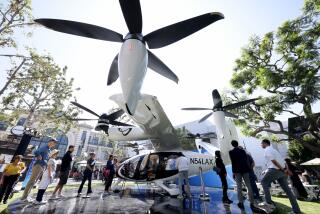Going Up on a Rubber Band and a Prayer
Itâs not hard to get George Heaven wound up about his project.
A kid who grew up hanging around airports, he washed airplanes in exchange for flying lessons. Now Heaven is the aeronautical engineer and designer who fine-tunes flying hot rods for the annual Reno air races. Parked in his hangar at Van Nuys Airport is Perestroika, a souped-up World War II Russian Yak now used in high-speed, piston-driven air races.
But delicately propped next to the fighter is something else--the worldâs biggest airplane powered by a rubber band.
Yes, a rubber band, like those that power cheap model planes for children.
Except this one is a big rubber band. The mother of all rubber bands.
Uncoiled, it could stretch from Van Nuys to Pasadena. Laid out on the floor of the hangar like a neat pile of spaghetti, Heaven and his crew of volunteer builders refer to the 90 pounds of oiled rubber as âthe motor.â
Despite three years of development, the Rubber Bandit, as Heavenâs plane is dubbed, hasnât flown yet. There are those who say it never will. But Heaven whips out a well-worn scientific calculator, tapping out figures that he says prove it will.
When Heaven takes off on the planeâs maiden flight, possibly by the end of July, he plans to be strapped into the bicycle seat suspended below the 71-foot wing, with a model airplane radio control box at his fingertips. Like its tiny cousins, all the planeâs controls work by radio signal, not by direct input.
According to Heavenâs calculations, seconds after the coiled rubber band is released, spinning a two-story-tall propeller at 550 revolutions per minute, the plane will lift off at a speed of 55 mph, cruise at 32 mph at an altitude of 50 to 100 feet, and land at 19 mph. The total flight will last less than two minutes and cover almost a mile.
Unless something goes wrong.
Like, say, the rubber band snaps.
*
âIf it quits vibrating, Iâll know Iâm in real trouble,â said the 44-year-old Woodland Hills designer.
Why is a respected aeronautical engineer doggedly pursuing a dream of building a plane not much different from the toys the Wright brothers played with as kids?
âNobody in their right mind is ever going to want a rubber band airplane,â Heaven said. âBut why do people climb the mountain?â
Actually, he and his crew are hoping to earn a place in the record books--as well as a spot for the plane in the National Air and Space Museum. No plane powered by a rubber band has ever carried a human aloft. Nor has anyone ever piloted a plane controlled solely by radio waves, other than by remote control.
In every respect, itâs the worldâs largest model airplane, crafted out of Space Age, ultralight, ultra-strong materials--like those used in bulletproof vests. Despite its size--it has a 33-foot-long fuselage--the plane, sans motor and pilot, weighs only 200 pounds.
Heaven was talked into the project in March 1994 when KLOS-FM deejays Mark Thompson and Brian Phelps were concocting another zany feat for their Bobâs Big Boy statue: planning to âflyâ it half a mile across the Grand Canyon, Evel Knievel-style. Heaven was called in as the engineering consultant.
After two months of calculating, Heaven announced that the 240-pound statue was just too heavy to feasibly perform the stunt. But a man, he said, could do it, and he wanted to be the pilot.
The deejays eventually gave up on the project after nine months of planning, but by then he was hooked, Heaven said, hoisting a three-inch-thick notebook of calculations. âThe Bandit turned into a business.â
Scores of volunteers have worked on the project, but only about 10 have stuck with it since the beginning, Heaven said.
Almost 100 sponsors have been recruited and hundreds of T-shirts have been sold all over the world to help fund the project, which has cost about $150,000 so far.
Construction has taken twice as long as expected, largely because of a lack of money, Heaven said. Now, only the wings remain to be finished.
*
Everything has been made by hand, including 108 carved wooden molds used to make up the composite pieces of the airplane. Even support stands and winding mechanisms for the rubber band had to be built from scratch.
âThere are no books written on it,â Heaven said.
He initially fashioned a small, crude wood model to test the concept. Then he painstakingly built a quarter-scale model, with a 17-foot wingspan, duplicating every detail, including materials to be used in the real thing.
One critical aspect will be the proper winding of the rubber band, which fits within the planeâs fuselage. Using a specially designed winch attached to a tractor, the rubber band will be stretched to three times its folded 25-foot length, then carefully wound from 600 to 800 rotations as the tractor slowly moves toward the plane, keeping the tension even.
Tests have shown that the rubber band will snap at 980 rotations, exploding with enough force to kill anyone in its path, Heaven said. A protective steel cage was fabricated to protect the tractor operator. The number of twists, without knotting, will determine the duration of the flight. Because the rubber begins losing power every second it spends fully wound up, Heaven said, quickness in getting the plane off the ground once the motor is wound will be critical to a successful flight.
News of the rubber band project has drawn widespread interest, particularly from science-oriented television programs that have broadcast the story around the world.
âThe interest is phenomenal. It shocks me every day,â said Heaven.
More to Read
Sign up for The Wild
Weâll help you find the best places to hike, bike and run, as well as the perfect silent spots for meditation and yoga.
You may occasionally receive promotional content from the Los Angeles Times.






